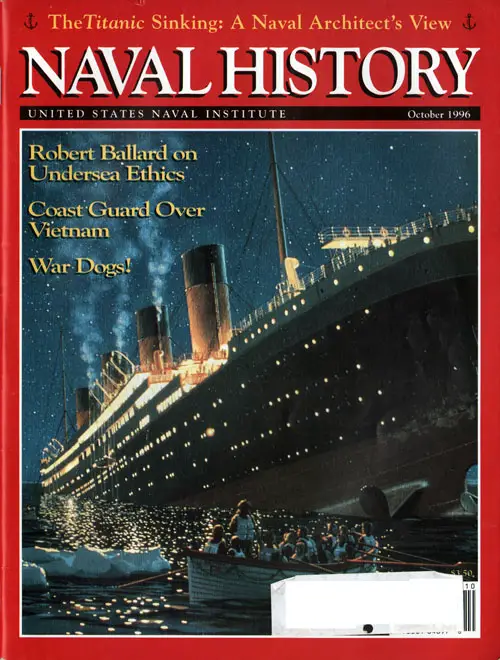Naval History - October 1996 - The Titanic Sinking

Front Cover, Naval History: A Publication of the United States Naval Institute, Volume 10, Number 5, September / October 1996. Articles Include The Titanic Sinking: A Naval Architect's View, Robert Ballard on Undersea Ethics, Coast Guard Over Vietnam, and War Dogs! GGA Image ID # 2188f4a94a
On The Cover
Ken Marschall’s paintings of the final hours of the Titanic appeared in Robert Ballard’s The Discovery of the Titanic (1987). This image depicts the ship as she must have looked at 02:05 on 15 April 1912. For more on the Titanic, see pages 15-23.
Featured Articles
How Did the Titanic Really Sink?
By William H. Garzke, Jr., and David K. Brown, Royal Corps of Naval Engineers
Naval architects torpedo the theory that a 300-foot gash sank the ship in 1912.
'It’s a Carnival'
An interview with Robert Ballard
The undersea explorer fires a shot against current Titanic preservation efforts.
'At Last We Were Safe'
By Admiral Giovanni Ciccolo, Italian Navy (Retired)
Translated by Eunice Rice and Enrico Pelitti
In 1943, one Italian officer saved five submarines from the Germans, repatriated imprisoned Italians, and secured passage home for 30 bed-ridden countrymen.
The Bridge Gets a New Look
Drawings by Colonel Charles Waterhouse, U.S. Marine Corps (Retired)
An eminent artist embellishes a classic of naval literature. The Bridge at Dong Ha.
Good-Bye, Mare Island
By Rich Pedroncelli
A historic naval landmark falls victim to military downsizing and consolidation.
Hurricane Uncovers 18th-Century Wreck
By Eric Adams
After Hurricane Andrew devastated south Florida, its only redeeming value may have been its unearthing of HMS Fowey, a 250-year-old British man-of-war.
The Coast Guard Flies in Vietnam
By Commander Doug Kroll, CHC, U.S. Naval Reserve
Coast Guard exchange pilots also risked it all in search-and-rescue missions.
The Hurricane Hunted
By Commander Edward P. Stafford, U.S. Navy (Retired)
A storm named Charlie got the best of the Navy’s Hurricane Hunters in 1950.
A Blind Eye Toward the Slave Trade
By Lieutenant Pegram Harrison, U.S. Naval Reserve (Retired)
Even though the Navy captured the slave ship Excellent in 1850, its record of otherwise suppressing the slave trade was abysmal.
Marine’s Best Friend
By Cyril J. O’Brien
Some of World War II’s most gallant warfighters were of the canine persuasion.
Departments
- Looking Back
- In Contact
- Museum Report
- Book Reviews
- Books of Interest
- Naval History News
- Salty Talk
- Historic Fleets
- Reunions
About This Issue
The sinking of the Titanic is arguably the most analyzed maritime disaster in history. In this issue, two underwater forensic experts and naval architects conclude that the ship sank because steel that had been weakened by low water temperatures succumbed to the weight of water rushing through a 12-foot- square hole in the bow.
In conjunction, we talk to Robert Ballard— Woods Hole Oceanographic Institution scientist, television host, and leader of the expedition that discovered the wreck of the Titanic— about the proposed raising of a hull section from the ship.
At the height of hurricane season, retired Commander Edward P. (The Big E) Stafford relates how a hurricane bested his squadron in 1950, and writer Eric Adams details how Hurricane Andrew uncovered a sunken ship in 1992.
Also in this issue is the enthralling tale of an Italian Navy lieutenant whose courage and quick thinking saved Italian lives after his country’s Armistice with the Allies in 1943.
